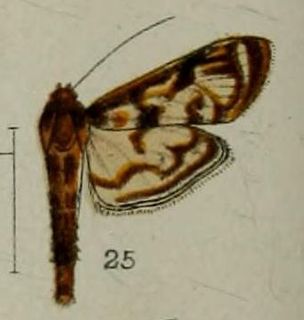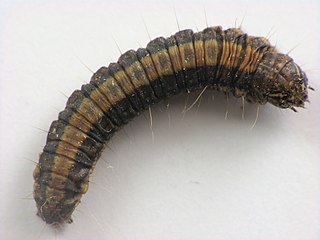Related Research Articles

Xylomyidae is a family of flies known commonly as the wood soldier flies. They are xylophagous and are associated with dead or dying wood.

Hypena is a genus of moths in the family Erebidae. It was first described by Franz von Paula Schrank in 1802. These non-migratory moths overwinter as pupae and almost never come to bait as adults.

Bradina is a genus of moths of the family Crambidae.

Glyphodes is a genus of moths of the family Crambidae described by Achille Guenée in 1854.

Herpetogramma is a genus of moths of the family Crambidae described by Julius Lederer in 1863. It currently comprises 106 species and is found in North America, Eurasia, Australia, New Zealand, Central and South America. Of the few species where host plants are known, the larvae mostly feed on grasses.
Lamprosema is a genus of moths of the family Crambidae described by Jacob Hübner in 1823.

Parapoynx is a genus of moths of the family Crambidae described by Jacob Hübner in 1825.

Phostria is a genus of moths of the family Crambidae.

Rhimphalea is a genus of small moths, which is part of the family Crambidae.

Syllepte is a genus of moths of the family Crambidae.

Hypsopygia is a genus of moths belonging to the family Pyralidae. Though fairly small, they are large among their relatives. It was described by Jacob Hübner in 1825.

The Chrysauginae are a subfamily of snout moths. They are primarily Neotropical and include about 400 described species.

The Epipaschiinae are a subfamily of snout moths. Almost 600 species are known today, which are found mainly in the tropics and subtropics. Some occur in temperate regions, but the subfamily is apparently completely absent from Europe, at least as native species. A few Epipaschiinae are crop pests that may occasionally become economically significant.
Rhimphalea sceletalis is a small moth in the family Crambidae that is found in Queensland in Australia and in Papua New Guinea. The species was first described by Julius Lederer in 1863.
Rhimphalea lindusalis is a moth in the family Crambidae. It was described by Francis Walker in 1859. It is found on Borneo, the Solomon Islands and Australia, where it has been recorded from Queensland.

Rhimphalea ochalis is a moth in the family Crambidae. It was described by Francis Walker in 1859. It is found in India, West Malaysia, Borneo, Sumatra, and Indonesia (Java). in lowlands to montane forests (1000 m).
Rhimphalea trogusalis is a moth in the family Crambidae. It was described by Francis Walker in 1859. It is found in the Himalayas, Assam, India, the Philippines, Borneo and Sulawesi.

Margaroniini is a tribe of the species-rich subfamily Spilomelinae in the pyraloid moth family Crambidae. The tribe was erected by Charles Swinhoe and Everard Charles Cotes in 1889.
References
- ↑ Nuss, M.; et al. (2003–2014). "GlobIZ search". Global Information System on Pyraloidea. Retrieved 2014-07-15.
- ↑ Savela, Markku. "Rhimphalea heranialis (Walker, 1859)". Lepidoptera and Some Other Life Forms. Retrieved January 31, 2018.
| This Margaroniini-related article is a stub. You can help Wikipedia by expanding it. |